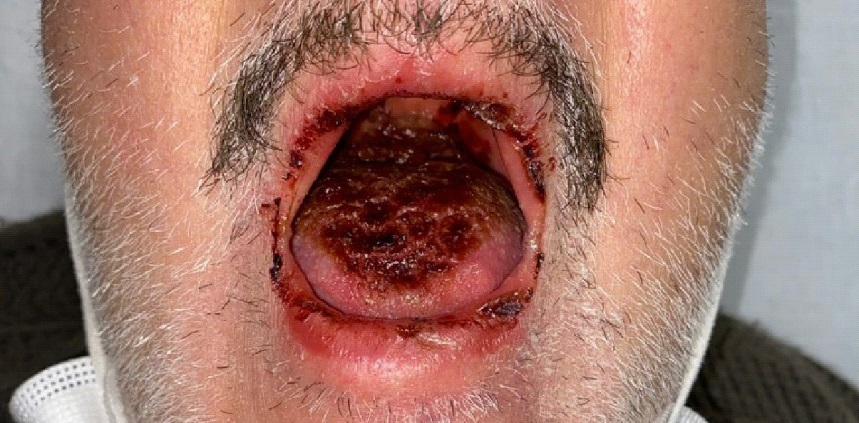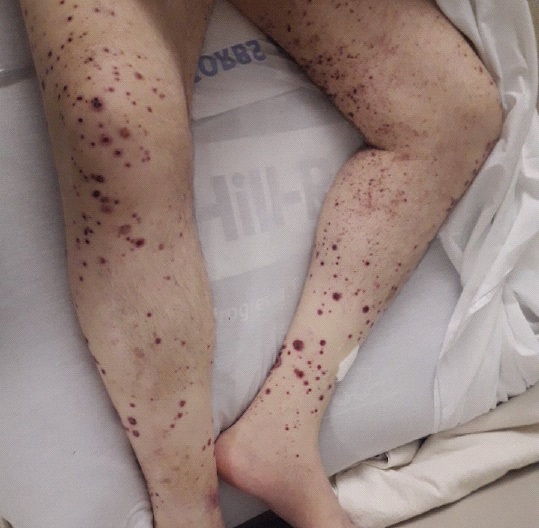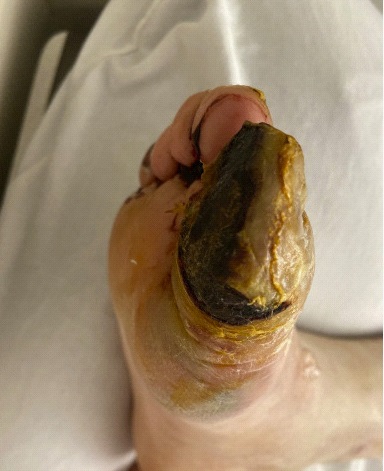
Journal of Clinical Images and Medical Case Reports
ISSN 2766-7820
Case Report - Open Access, Volume 2
A 62-year-old man with a purpuric rash and acute kidney injury
Marta Lorente-Ros1*; Shabari Mangalore Shenoy1; Joseph P Matthew 2
1Department of Medicine, Mount Sinai Morningside and Mount Sinai West, Icahn School of Medicine at Mount Sinai, New York,USA.
2 Division of Pulmonary, Critical Care and Sleep Medicine, Mount Sinai Morningside and Mount Sinai West, Icahn School of Medicine at Mount Sinai, New York, USA.
*Corresponding Author : Marta Lorente-Ros
Department of Medicine, Mount Sinai Morningside
and Mount Sinai West, Icahn School of Medicine at
Mount Sinai, New York, USA
Email: marta.lorenteros@mountsinai.org
Received : Apr 14, 2021
Accepted : May 04, 2021
Published : May 07, 2021
Archived : www.jcimcr.org
Copyright : © Lorente-Ros M (2021).
Abstract
Staphylococcus aureus bacteremia can infrequently present as vasculitis or Acute Glomerulonephritis (AGN). The association between Staphylococcus aureus bacteremia and these immune-mediated responses is rare and remains a diagnostic challenge. We present a case of a 62-year-old man with hypertension, hyperlipidemia, and type II diabetes mellitus who presented with joint pain, hematuria and a purpuric rash in his legs and oral cavity after he dropped a bag of heavy metal on his right foot. He was found to have acute glomerulonephritis with rapidly progressing renal failure requiring emergent hemodialysis. At first, the presentation seemed to be of a rheumatologic origin and he was initially managed with methylprednisolone. However, further work-up revealed methicillin-sensitive Staphylococcus aureus bacteremia. The right toe was amputated for source control and the patient was treated with antibiotics. This case is, to our knowledge, the first reported clinical presentation of Staphylococcus aureus bacteremia manifesting as purpuric rash, glomerulonephritis, and joint pain. It highlights the importance of making an initial differential diagnosis between a rheumatologic and an infectious disorder, as initial suspicion would change initial management and prognosis.
Keywords: Bacteremia; Vasculitis; Glomerulonephritis; Staphylococcus aureus.
Abbreviations: AGN: Acute glomerulonephritis; MSSA: Methicillinsensitive Staphylococcus aureus; MRSA: Methicillin-resistant Staphylococcus aureus.
Citation: Lorente-Ros M, Shenoy SM, Matthew JP. A 62-year-old man with a purpuric rash and acute kidney injury. J Clin Images Med Case Rep. 2021; 2(3): 1124.
Introduction
Staphylococcus aureus bacteremia can infrequently present as vasculitis or Acute Glomerulonephritis (AGN). The association between Staphylococcus aureus bacteremia and these immune-mediated responses has been established as rare, mostly with Methicillin-Resistant Staphylococcus Aureus (MRSA) [1-3]. In spite of increasing incidence of these immune-mediated phenomena over the past decade, the clinical suspicion for these entities is still low, and the initial differential diagnosis remains a challenge.
Case presentation
A 62-year-old man presented with a purpuric rash in his legs and oral cavity after he dropped a bag of heavy metal on his right foot. His comorbidities included hypertension, hyperlipidemia, and insulin-dependent type II diabetes mellitus. He was a former smoker who drank alcohol occasionally, and he did not use any recreational drugs. Past medical history and family history were unremarkable for connective tissue diseases, dermatologic diseases or malignancies. He also reported joint pain in shoulders, elbows, wrists, interphalangeal joints, knees and ankles bilaterally. He endorsed hematuria and dark colored urine. Review of systems was otherwise negative.
Upon evaluation in the emergency department, he was afebrile, his blood pressure was 125/80 mmHg, his heart rate was 95 beats per minute, he was breathing at 18 respirations per minute and peripheral oxygen saturation was 97% on room air.
On physical exam, he appeared well and was awake and alert. Lungs were clear to auscultation and heart sounds were normal. Oral mucosae showed hemorrhagic lesions (Figure 1). He had a bilateral palpable purpuric rash extending from the feet to the lower abdomen (Figure 2), as well as a necrotic lesion on the right toe (Figure 3).
The differential diagnosis of this clinical presentation included infectious vasculitis, cryoglobulinemia, drug induced vasculitis, ANCA mediated vasculitis, polyarteritis nodosa, HenochSchönlein purpura, other forms of leukocytoclastic vasculitis, and thrombotic thrombocytopenic purpura, among others.
Initial work up and management
The white blood cell count was 19,400/microliter (94% of which were neutrophils), the hemoglobin was 11 g/deciliter, and the platelet count was 63,000/microliter. The BUN was 154 mg/deciliter, the creatinine was 6.9 mg/deciliter, and the electrolytes were within normal limits. Liver function tests including bilirubin were within normal range. In the initial venous blood gas, the pH was 7.22, the pCO2 was 28 mmHg, the bicarbonate was 11.5 mEq/liter, and the lactic acid was 5.2 mmol/liter. The urinalysis was significant for hematuria and proteinuria. X-ray of the foot showed a comminuted fracture of the distal phalanx of the first toe, with surrounding tissue edema and subcutaneous air.
The patient was admitted to the intensive care unit for metabolic acidosis and acute kidney injury.
As the main diagnostic consideration of this clinical presentation was an autoimmune disease, the patient received methylprednisolone. Nevertheless, antibiotics (cefepime and vancomycin) were also administered given the leukocytosis and that an infectious process could not be ruled out. The patient also required urgent hemodialysis on arrival to the intensive care unit.
Results
Antibodies for hepatitis B and C were negative. HIV (Human Immunodeficiency Virus) and syphilis testing was negative. Cryoglobulins were negative. ADAMS-13 activity was decreased to 29.1%, but antibodies against ADAM-13 were negative. ANCA antibodies (antiMPO, antiPR3, cANCA, pANCA) were negative as well. C3 fraction of the complement was low (72 miligrams/dL), while C4 fraction was normal. Antibodies associated with other rheumatologic conditions were negative. IgA levels were high (859 miligrams/dL), while IgG and IgM levels were low. Hemoglobin A1c was 12.2%.
Blood cultures drawn on admission grew Methicillin Sensitive Staphylococcus Aureus (MSSA) on the third day of hospitalization. Punch biopsy of the purpuric rash in the lower extremities showed gram positive cocci in clusters. Dermatology was consulted and the patient was diagnosed with cutaneous vasculitis. Biopsy of the right first toe showed gangrenous necrosis of skin and soft tissue with acute osteomyelitis.
Clinical course and outcome
During hospitalization in the intensive care unit, methylprednisolone was stopped when the blood cultures grew MSSSA and the patient was maintained on antibiotics. The necrotic right toe was amputated for source control. Daily electrocardiograms showed no abnormalities. The patient required intermittent hemodialysis during his hospital course.
On day 7 of hospitalization, the patient had an acute change in mental status characterized by lethargy and difficult arousal. He was then intubated for labored breathing with periods of apnea, and became hypotensive requiring vasopressors in addition to fluid resuscitation.
MRI of the brain showed new infarcts on bilateral white matter. The infarcts were located predominantly on bilateral corona radiata, but also on bilateral temporo-parietal regions, left parieto-occipital region, and right cerebellar hemisphere. Transesophageal echocardiogram showed a 0.9 by 0.3 cm vegetation in the aortic valve.
The patient required vasopressor support for 20 days and was intubated for 20 days. He persistently failed spontaneous breathing trials. A tracheostomy was done after 20 days of intubation and the patient remained dependent of mechanical ventilation with no improvement in his mentation. His renal function did not improve and he continued to require intermittent hemodialysis.
Due to lack of improvement in mental status, a goals of care discussion with family members and the palliative care team took place. After this discussion, a decision was made to transfer the patient to hospice care.
Discussion
This case represents an unusual presentation of Staphylococcus aureus bacteremia as autoimmune phenomena (vasculitis and AGN) in an immunocompetent patient, and illustrates the challenge of making a differential diagnosis with a rheumatologic condition in the first encounter, before blood cultures and other initial work-up results. Indeed, the clinical presentation, with characteristic cutaneous changes and joint symptoms, suggested an autoimmune process whereas the true etiology, as later confirmed by blood culture results, was less obvious. This diagnostic difficulty is not only of academic interest, but also of relevance for clinical practice, as delayed treatment is associated with a worse prognosis.
Based on the initial assessment of this patient, corticosteroid treatment was the initial consideration given the suspicion of an immune-mediated condition, whereas the treatment for sepsis would have been the initial approach if an infectious etiology had been suspected. Outcome and prognosis is impacted by the initial management, as corticosteroid treatment and delayed antibiotic treatment may worsen the infection, whereas antibiotics and delayed immunosuppressive therapy may allow progression of the autoimmune process. The initial challenge is still more complex, as both processes may coexist if the infection triggers an immune complex mediated response, as it happened in the present case. In fact, there have been previous reports of negative outcomes in Staphylococcal associated glomerulonephritis treated with corticosteroids [4], mostly in the setting of a complex initial differential diagnosis with primary immune glomerulonephritis [5] or a post-infectious glomerulonephritis [6].
There are rare previous reports in the literature about Staphylococcus aureus bacteremia having cutaneous manifestations or glomerulonephritis [7-9]. This is the first reported case to our knowledge of traumatic-induced MSSA bacteremia presenting as joint pain, vasculitis and glomerulonephritis.
One limitation of the present case is the lack of a kidney biopsy confirmatory of the clinical diagnosis of AGN. However, we consider that the diagnosis of AGN is sufficiently supported in the present clinical context of polyarthralgia, vasculitis, hematuria and proteinuria, and new onset rapidly progressing renal failure. Staphylococcus aureus associated glomerulonephritis has been described as a rare form of glomerulonephritis with an increasing incidence over the past decade [1,10,11]. It has been recognized as a very different entity from post-infectious glomerulonephritis, both in pathogenesis and treatment [4]. Although it is more commonly associated with Methycillin-Resistant Staphylococcus Aureus (MRSA), it can also occur in MSSA [2], as in this case. It usually presents as acute kidney injury, hematuria and proteinuria. The pathogenesis appears to be immune complex mediated, although it remains unclear [10], with some authors suggesting a role of microbial superantigens in the development of both glomerulonephritis and vasculitis [12]. This form of glomerulonephritis has been associated with skin manifestations in up to 29% of cases in a recent series [3]. The prognosis differs from post-infectious glomerulonephritis, with age and diabetes mellitus independently associated with a worse prognosis [3].
Conclusion
This is, to our knowledge, the first reported case of traumatic-induced MSSA bacteremia presenting as joint pain, vasculitis and glomerulonephritis. It illustrates the challenge of an initial differential diagnosis between infectious and rheumatologic conditions, and reminds the clinician of the possibility of an infectious etiology triggering an immune mediated condition.
References
- Hemminger J, Satoskar A. Staphylococcus infection-associated glomerulonephritis. In: Satoskar A, Nadasdy T, eds. Bacterial Infections and the Kidney. New York, NY: Springer. 2017: 37-61.
- Wehbe E, Salem C, Simon JF, Navaneethan SD, Pohl M. IgA-dominant Staphylococcus infection-associated glomerulonephritis: Case reports and review of the literature. NDT Plus. 2011; 4: 181–185.
- Wang SY, Bu R, Zhang Q, Liang S, Wu J, Liu X-GZS-W, et al. Clinical, Pathological, and Prognostic Characteristics of Glomerulonephritis Related to Staphylococcal Infection. Medicine (Baltimore). 2016; 95.
- Glassock RJ, Alvarado A, Prosek J, Hebert C, Parikh S, et al. Staphylococcus-Related Glomerulonephritis and Poststreptococcal Glomerulonephritis: Why Defining “Post” Is Important in Understanding and Treating Infection-Related Glomerulonephritis. Am J Kidney Dis. 2015; 65: 826–832.
- Satoskar AA, Molenda M, Scipio P, Shim R, Zirwas M, et al. Henoch-Schönlein purpura-like presentation in IgA-dominant Staphylococcus infection-associated glomerulonephritis - A diagnostic pitfall. Clin Nephrol. 2013; 79: 302–312.
- Okuyama S, Wakui H, Maki N, Kuroki J, Nishinari T, et al. Successful treatment of post-MRSA infection glomerulonephritis with steroid therapy. Clin Nephrol. 2008; 70: 344–347.
- Mosher CA, Owen JL, Barker BR. Staphylococcus aureus Bacteremia Masquerading as Leukocytoclastic Vasculitis. Am J Med. 2016; 129: e5–7.
- Mahmood T, Puckrin R, Sugar L, Naimark D. StaphylococcusAssociated Glomerulonephritis Mimicking Henoch-Schönlein Purpura and Cryoglobulinemic Vasculitis in a Patient With an Epidural Abscess: A Case Report and Brief Review of the Literature. Can J Kidney Health Dis. 2018; 5.
- Uggeri S, Fabbian F, Catizone L. Henoch–Schönlein purpura due to methicillin-sensitive Staphylococcus aureus bacteremia from central venous catheterization. Clin Exp Nephrol. 2008; 12: 219– 223.
- Nadasdy T, Hebert LA. Infection-Related Glomerulonephritis: Understanding Mechanisms. Semin Nephrol. 2011; 31: 369– 375.
- Satoskar AA, Nadasdy G, Plaza JA, Sedmak D, Shidham G, Hebert L, et al. Staphylococcus Infection-Associated Glomerulonephritis Mimicking IgA Nephropathy. Clin J Am Soc Nephrol. 2006; 1: 1179–1186.
- Koyama A, Kobayashi M, Yamaguchi N, Yamagata K, Takano K, Nakajima M, et al. Glomerulonephritis associated with MRSA infection: A possible role of bacterial superantigen. Kidney Int. 1995; 47: 207–216.



